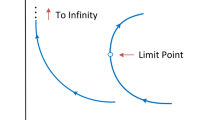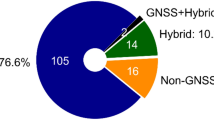Abstract
In this paper, the performance of two distinct classes of feedback guidance algorithms is evaluated for a spacecraft rendezvous problem utilizing a continuous low-thrust propulsion system. They are the DG (Differential Geometric) and ZEM/ZEV (Zero-Effort-Miss/Zero- Effort-Velocity) feedback guidance algorithms. Even though these two guidance algorithms do not attempt to minimize the onboard fuel consumption or ΔV directly, the ΔV requirement is used as a measure of their orbital rendezvous performance for various initial conditions and a wide range of the rendezvous time (within less than one orbital period of the target vehicle). For the DG guidance, the effects of its guidance parameter and terminal time on the closed-loop performance are evaluated by numerical simulations. For the ZEM/ZEV guidance, its nearfuel- optimality is further demonstrated for a rapid, short-range orbital rendezvous, in comparison with the corresponding open-loop optimal solutions. Furthermore, the poor ΔV performance of the ZEM/ZEV guidance for a slow, long-range orbital rendezvous is remedied by simply adding an initial drift phase. The ZEM/ZEV feedback guidance algorithm and its appropriate variants are then shown to be a simple practical solution to a non-impulsive rendezvous problem, in comparison with the DG guidance as well as the open-loop optimal guidance.
Similar content being viewed by others
Change history
11 February 2022
A Correction to this paper has been published: https://doi.org/10.1007/s42064-022-0136-2
References
Goodman, J. L. History of space shuttle rendezvous and proximity operations. Journal of Spacecraft and Rockets, 2006, 43(5): 944–959.
Barbee, B., Carpenter, J. R., Heatwole, S., Markley, F. L., Moreau, M., Naasz, B. J., Van Eepoel, J. A guidance and navigation strategy for rendezvous and proximity operations with a noncooperative spacecraft in geosynchronous orbit. The Journal of the Astronautical Sciences, 2011, 58(3): 389–408.
Wen, C., Gurfil, P. Guidance, navigation and control for autonomous R-bar proximity operations for geostationary satellites. Proceedings of the Institution of Mechanical Engineers, Part G: Journal of Aerospace Engineering, 2017, 231(3): 452–473.
Luo, Y.-Z., Sun, Z.-J. Safe rendezvous scenario design for geostationary satellites with collocation constraints. Astrodynamics, 2017, 1(1): 71–83.
Zhang, S., Han, C., Sun, X. New solution for rendezvous between geosynchronous satellites using low thrust. Journal of Guidance, Control, and Dynamics, 2018, 41(6): 1396–1405.
Wang, W., Chen, L., Li, K., Lei, Y. One active debris removal control system design and error analysis. Acta Astronautica, 2016, 128: 499–512.
Wang, W., Song, X., Li, K., Chen, L. A novel guidance scheme for close range operation in active debris removal. Journal of Space Safety Engineering, 2018, 5(1): 22–33.
Chiou, Y.-C., Kuo, C.-Y. Geometric approach to three-dimensional missile guidance problem. Journal of Guidance, Control, and Dynamics, 1998, 21(2): 335–341.
Kuo, C.-Y., Chlou, Y.-C. Geometric analysis of missile guidance command. IEEE Proceedings: Control Theory and Applications, 2000, 147(2): 205–211.
Kuo, C.-Y., Soetanto, D., Chiou, Y.-C. Geometric analysis of flight control command for tactical missile guidance. IEEE Transactions on Control Systems Technology, 2001, 9(2): 234–243.
Li, C., Jing, W., Wang, H., Qi, Z. iterative solution to differential geometric guidance problem. Aircraft Engineering and Aerospace Technology, 2006, 78(5): 415–425.
Li, C., Jing, W. Analysis of 3D geometric guidance problem. Transactions of the Japan Society for Aeronautical and Space Sciences, 2008, 51(172): 124–129.
Li, C., Jing, W., Qi, Z., Wang, H. A novel approach to the 2D differential geometric guidance problem. Transactions of the Japan Society for Aeronautical and Space Sciences, 2007, 50(167): 34–40.
Li, C.-Y., Jing, W.-X. Fuzzy PID controller for 2D differential geometric guidance and control problem. IET Control Theory & Applications, 2007, 1(3): 564–571.
Li, C., Jing, W., Wang, H., Qi, Z. Gain-varying guidance algorithm using differential geometric guidance command. IEEE Transactions on Aerospace and Electronic Systems, 2010, 46(2): 725–736.
Dhananjay, N., Ghose, D., Bhat, M. S. Capturability of a geometric gudiance law in relative velocity space. IEEE Transactions on Control Systems Technology, 2009, 17(1): 111–122.
Li, K., Chen, L., Bai, X. Differential geometric modeling of guidance problem for interceptors. Science China Technological Sciences, 2011, 54(9): 2283–2295.
Li, K., Chen, L., Tang, G. Improved differential geometric guidance commands for endoatmospheric interception of high-speed targets. Science China Technological Sciences, 2013, 56(2): 518–528.
Li, K., Chen, L., Tang, G. Algebraic solution of differential geometric guidance command and time delay control. Science China Technological Sciences, 2015, 58(3): 565–573.
Li, K., Su, W., Chen, L. Performance analysis of threedimensional differential geometric guidance law against low-speed maneuvering targets. Astrodynamics, 2018, 2(3): 233–247.
Ariff, O., Zbikowski, R., Tsourdos, A., White, B. A. Differential geometric guidance based on the involute of the target’s trajectory. Journal of Guidance, Control, and Dynamics, 2005, 28(5): 990–996.
White, B. A., Zbikowski, R., Tsourdos, A. Direct intercept guidance using differential geometric concepts. IEEE Transactions on Aerospace and Electronic Systems, 2007, 43(3): 899–919.
Meng, Y., Chen, Q., Ni, Q. A new geometric guidance approach to spacecraft near-distance rendezvous problem. Acta Astronautica, 2016, 129: 374–383.
Ebrahimi, B., Bahrami, M., Roshanian, J. Optimal sliding-mode guidance with terminal velocity constraint for fixed-interval propulsive maneuvers. Acta Astronautica, 2008, 62(10–11): 556–562.
Furfaro, R., Selnick, S., Cupples, M. Nonlinear sliding guidance algorithms for precision lunar landing. In: Proceedings of the 21st AAS/AIAA Space Flight Mechanics Meeting, 2011: AAS 2011–167.
Guo, Y., Hawkins, M., Wie, B. Optimal feedback guidance algorithms for planetary landing and asteroid intercept. In: Proceedings of the AAS/AIAA Astrodynamics Specialist Conference, 2011: AAS 2011–588.
Guo, Y., Hawkins, M., Wie, B. Applications of generalized zero-effort-miss/zero-effort-velocity feedback guidance algorithm. Journal of Guidance, Control, and Dynamics, 2013, 36(3): 810–820.
Guo, Y., Hawkins, M., Wie, B. Waypoint-optimized zero-effort-miss/zero-effort-velocity feedback guidance for Mars landing. Journal of Guidance, Control, and Dynamics, 2013, 36(3): 799–809.
Ahn, J., Guo, Y., Wie, B. Precision ZEM/ZEV feedback guidance algorithm utilizing Vinti’s analytic solution of perturbed Kepler problem. In: Proceedings of the AAS/AIAA Space Flight Mechanics Meeting, 2016: AAS 16–345.
Ahn, J., Wang, P., Guo, Y., Wie, B. Optimal terminaltime determination for the ZEM/ZEV feedback guidance law. Astrodynamics, 2019. (to be published)
Wie, B. Two-phase ZEM/ZEV guidance for Mars and Lunar powered descent & landing with hazard avoidance and retargeting. Keynote Talk in the 4th IAA Conference on Dynamics and Control of Space Systems, 2018.
Wie, B., Zimmerman, B., Lyzhoft, J., Vardaxis, G. Planetary defense mission concepts for disruptiong/pulverizing harzadous asteroids with short wanrning time. Astrodynamics, 2017, 1(1): 3–21.
Acknowledgements
This work is supported by the National Natural Science Foundation of China (Grant Nos. 61673135 and 61603114).
Author information
Authors and Affiliations
Corresponding author
Additional information
Pengyu Wang received his B.S. degree in automation from Harbin Engineering University, China, in 2015, and M.S. degree in control science and engineering from Harbin Institute of Technology, China, in 2017. He is now a Ph.D. candidate at Harbin Institute of Technology focusing on the development and application of control theories in aerospace problems, including Mars pinpoint landing, spacecraft rendezvous, and missile impact-time guidance, etc.
Yanning Guo received his Ph.D. degree in control science and engineering from Harbin Institute of Technology, China, in 2012, and was a visiting scholar at Iowa State University in 2010–2011. Currently, he is an associate professor at Harbin Institute of Technology, and specializes in optimal control, sliding-mode control, as well as visual navigation and localization.
Bong Wie is a professor of aerospace engineering at Iowa State University. He is the founding director of the Asteroid Deflection Research Center established in 2008 at Iowa State University. He received his M.S. and Ph.D. degrees in aeronautics and astronautics from Stanford University in 1978 and 1981, respectively. In 2006, the AIAA (American Institute of Aeronautics and Astronautics) presented Prof. Wie with the Mechanics and Control of Flight Award for his innovative research on advanced control of complex spacecraft such as agile imaging satellites, solar sails, and large space structures.
Rights and permissions
About this article
Cite this article
Wang, P., Guo, Y. & Wie, B. Orbital rendezvous performance comparison of differential geometric and ZEM/ZEV feedback guidance algorithms. Astrodyn 3, 79–92 (2019). https://doi.org/10.1007/s42064-018-0037-6
Received:
Accepted:
Published:
Issue Date:
DOI: https://doi.org/10.1007/s42064-018-0037-6




